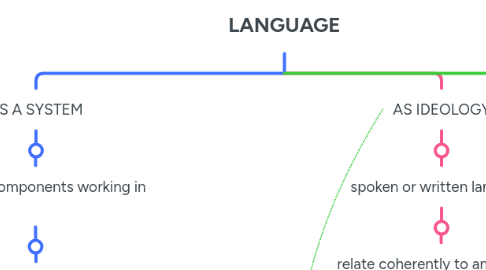
1. AS A SYSTEM
1.1. Different components working in tandem
1.1.1. coherent and systemic
1.1.1.1. 3 subsystems
1.1.1.1.1. PHONOLOGICAL SYSTEM
1.1.1.1.2. SEMANTIC SYSTEM
1.1.1.1.3. SYNTACTIC SYSTEM
2. Chomsky
2.1. the poverty of stimulus
2.1.1. Child's 1st language: poor imput can produce rich output
2.2. Competence vs performance
2.2.1. Competence
2.2.1.1. the speaker-hearer´s knowledge of his/her language
2.2.1.1.1. Linguistic competence or gramatical competence
2.2.2. Performance
2.2.2.1. The actual use of language insituation
2.3. allow people to combine ... to form
2.3.1. phonemes
2.3.1.1. words
2.3.1.1.1. phrases
2.4. Universal grammar
2.4.1. concepts, principles and parameters goberning the grammatical structure of all languages
2.4.1.1. genetically encoded
2.4.1.1.1. Unconscious - innate ability
3. AS IDEOLOGY
3.1. spoken or written language
3.1.1. relate coherently to an external communicative purpose and a given audience
3.1.1.1. connected and contextualize
3.1.1.1.1. gain notoriety in1970
4. HALLIDAY
4.1. defined language as MEANING POTENTIAL
4.1.1. 3 metafunctions
4.1.1.1. ideational
4.1.1.1.1. the individual's meaning potential
4.1.1.2. interpersonal
4.1.1.2.1. individual's relationships with people
4.1.1.3. textual
4.1.1.3.1. the linguistic realizationof the ideational and interpersonal functions
5. HYMES
5.1. Expand the Chomskian view about COMPETENCE
5.1.1. structure of tacit knowledge possessed by the speaker-hearer
5.1.1.1. plus the COMMUNICATIVE ABILITY to use the language in a CONCRETE SITUATION
5.1.1.1.1. to whom
5.1.1.1.2. where
5.1.1.1.3. when
5.1.1.1.4. in what manner
6. AUSTIN
6.1. speech act
6.1.1. locution
6.1.2. illocution
6.1.3. perlocution
7. AUTHORS
7.1. KROSKRITY
7.1.1. 4 converging dimensions
7.2. FOUCALT
7.2.1. 3 dimensional definitions of discourse
7.2.1.1. general domain of all statements
7.2.1.1.1. all actual utterances or texts
7.2.1.2. individualizable group of statements
7.2.1.2.1. specific formations of fields
7.2.1.3. a regulate practice that account for a number of statements
7.2.1.3.1. socio-political structures
7.3. BORDIEU
7.3.1. language as simbolic power
7.3.1.1. making people see and believe
7.3.1.1.1. transforming the vision of the world
7.3.2. asymmetries in power
7.3.2.1. who controls
7.3.2.1.1. the production
7.3.2.1.2. distribution
7.3.2.1.3. consume
8. AS DISCORD
8.1. sistematic body of ideas
8.1.1. organized in a particular point of view
9. comunicative language
9.1. knowledge/ability
9.1.1. consist of grammatical language as well as sociolinguistic one
9.1.1.1. 8 factors to govern succesful communication
9.1.1.1.1. SPEAKING
